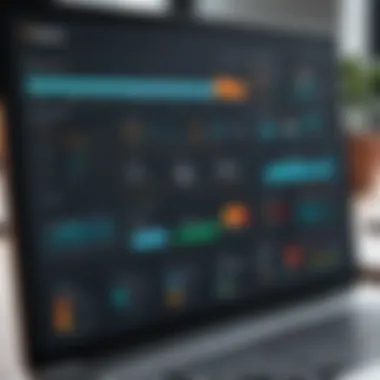Understanding Jaggaer RFP: Features and Insights


Intro
The Jaggaer RFP platform emerges as a vital element in modern procurement processes. With organizations navigating complex purchasing landscapes, the need for an efficient Request for Proposal system becomes essential. Jaggaer RFP offers various tools to streamline vendor selection and enhance decision-making. In this article, we will delve into the platform’s features, strengths, and weaknesses, providing a nuanced evaluation for IT managers and business decision-makers.
Features Overview
Key Functionalities
Jaggaer RFP is designed to facilitate a seamless procurement experience. At its core, the platform provides:
- A user-friendly interface.
- Customizable workflows for RFP publication and management.
- Advanced analytics to track vendor performance and proposal evaluations.
- Real-time collaboration features, allowing teams to work simultaneously.
These functionalities enable organizations to streamline the proposal process, allowing for faster and more accurate vendor selection. The ability to customize workflows means that different procurement strategies can be implemented without losing efficiency.
Integration Capabilities
Integration with existing systems is crucial for any procurement platform. Jaggaer RFP supports multiple integrations, including:
- ERP systems such as SAP and Oracle.
- CRM platforms like Salesforce to manage client relations more effectively.
- E-procurement solutions to harness comprehensive sourcing capabilities.
This flexibility allows organizations to leverage their current technology stack and enhance overall procurement effectiveness without requiring an extensive overhaul. The interoperability between Jaggaer and other systems paves the way for a more cohesive and efficient procurement strategy.
Pros and Cons
Advantages
Jaggaer RFP boasts several advantages:
- Enhanced efficiency: The platform’s tools simplify RFP creation, reducing the time spent on manual tasks.
- Data-driven decisions: With robust analytics, organizations can make informed choices based on vendor performances and historical data.
- Collaboration improvement: Real-time updates and document sharing streamline teamwork across departments.
Disadvantages
However, Jaggaer RFP does have some drawbacks:
- Steep learning curve: New users may face challenges in navigating the platform, which may delay its adoption.
- Pricing model: For smaller businesses, the cost of the service can be a concern when compared to other available options.
A well-implemented RFP platform can save organizations both time and resources, leading to more strategic procurement practices.
Intro to Jaggaer RFP
Understanding Jaggaer RFP is integral for organizations looking to enhance their procurement operations. This platform offers a systematic approach to managing requests for proposals (RFPs). The importance of effective RFP management cannot be overstated, as it directly impacts supplier selection and procurement efficiency.
Overview of Jaggaer
Jaggaer is a procurement platform designed to streamline the sourcing processes for businesses of various sizes. Its suite of tools provides users with options for category management, spend analysis, and supplier management. Jaggaer is geared towards improving transparency and efficiency in procurement through automation and real-time data access.
By leveraging cloud-based solutions, Jaggaer allows organizations to access their procurement data anywhere, accommodating the increasing mobile workforce. This capability aids in maintaining continuity and agility in the procurement process. The system is built not just for managing RFPs, but also for fostering stronger relationships between buyers and suppliers by enhancing collaboration.
Concept of RFP in Procurement
The concept of RFP in procurement is essential for facilitating purchasing decisions within organizations. RFPs, or requests for proposals, are formal documents that solicit detailed proposals from suppliers for specific projects or products. This mechanism allows for comparison of different solutions, ensuring that decision-makers can select the best fit for their needs.
RFPs serve several key purposes in procurement:


- Clarification of Needs: RFP documents help organizations articulate their requirements clearly.
- Competitive Bidding: By inviting multiple suppliers to compete, RFPs can lead to better pricing and innovation.
- Benchmarking: An RFP provides a common standard against which to assess the services and products offered by various suppliers.
In summary, Jaggaer RFP encapsulates the broader goals of procurement by ensuring that organizations not only acquire necessary goods and services but also do so in a strategic manner that enhances overall business performance.
"Effective RFPs are the backbone of successful procurement strategies."
The Jaggaer RFP is part of a growing trend towards integrated procurement solutions, enabling organizations to realize significant improvements in their procurement processes.
Key Features of Jaggaer RFP
Understanding the key features of Jaggaer RFP is crucial for decision-makers in procurement. These features reflect how effectively the platform can streamline processes, enhance user experience, and facilitate collaboration among stakeholders. By examining these attributes, businesses can assess the software’s alignment with their procurement needs and overall strategy.
User Interface and Experience
The user interface (UI) of Jaggaer RFP prioritizes efficiency and ease of use. A clean layout allows users to navigate the platform intuitively. This design minimizes the learning curve for new users, making onboarding smoother.
Moreover, the experience is enhanced through customizable dashboards. Users can arrange functionalities based on their preferences and responsibilities. This level of personalization can significantly improve user satisfaction and engagement. In addition, the consistency in design across various modules helps in reducing cognitive load, allowing users to focus on tasks without unnecessary distractions.
Proposal Management Tools
Jaggaer RFP incorporates robust proposal management tools that simplify the submission and evaluation of proposals. The platform supports template creation which enables procurement teams to standardize documents. This standardization ensures consistency and helps in maintaining compliance across all proposals.
Additionally, users can track submissions in real-time, making it easier to monitor progress. Stakeholders can receive notifications when proposals are submitted or updated. This feature enhances communication between suppliers and procurement teams.
Collaboration Capabilities
Collaboration is vital in procurement processes, and Jaggaer RFP excels in this area. The platform supports multiple user access levels, allowing teams to work together seamlessly. Users can comment on proposals and share insights directly within the platform, streamlining discussions and decision-making.
Furthermore, integrated messaging tools ensure that communication remains organized. These capabilities foster a collaborative environment where procurement teams can engage suppliers and internal stakeholders effectively.
Analytics and Reporting Features
Analytics and reporting are essential for informed decision-making in procurement. Jaggaer RFP offers comprehensive analytics tools that provide insights into submission trends, supplier performance, and overall procurement efficiency.
Users can generate tailored reports that highlight key metrics relevant to their objectives. This data-driven approach enables organizations to make strategic decisions based on solid evidence rather than assumptions.
Moreover, visual representations of data improve comprehension and help stakeholders grasp complex information quickly.
The effectiveness of Jaggaer RFP emerges from its intuitive features, fostering a streamlined procurement environment that promotes collaboration and empowers users with data.
Benefits of Using Jaggaer RFP
The Jaggaer RFP platform offers significant advantages for organizations looking to optimize their procurement processes. Understanding these benefits is essential for decision-makers who must evaluate tools that enhance efficiency and drive better engagement with suppliers. This platform provides a means to automate complex workflows while ensuring compliance and fostering collaboration. Each advantage contributes to a more effective procurement strategy, making the platform a critical asset in today's dynamic business environment.
Streamlined Procurement Process
A streamlined procurement process is vital for operational success. Jaggaer RFP simplifies the steps involved, reducing bottlenecks that can stagnate progress. With an easy-to-use interface, employees can create, manage, and track requests much quicker than traditional methods. This reduces the time spent on administrative tasks, allowing staff to focus on more strategic initiatives.
Moreover, automated notifications remind users of important deadlines, ensuring that nothing is overlooked. Task assignment among team members becomes efficient as the software handles approvals and captures comments from relevant stakeholders. This continuous flow minimizes lag times, thereby accelerating decision-making and ultimately improving relevant metrics like cost savings.
"A well-optimized process not only drives efficiency but also enhances overall stakeholder satisfaction and organizational performance."
Enhanced Supplier Engagement


Engaging with suppliers effectively is key to procurement success. Jaggaer RFP fosters improved communication channels, which create a more transparent environment. Suppliers can access relevant information easily, leading to more informed proposals. The platform supports direct interaction, whether through messaging features or real-time updates on request statuses.
A robust supplier onboarding process further enhances engagement. This encourages suppliers to take a proactive role in proposals and increases their willingness to collaborate. By making interactions easier and more productive, organizations can build stronger, lasting relationships with vendors, which leads to better pricing and service terms.
Managers often find that enhanced supplier engagement translates to better outcomes. Suppliers that feel valued and understood are more likely to deliver quality results and adapt to evolving business needs.
Improved Compliance Management
Compliance is a critical element in procurement. Jaggaer RFP helps organizations manage this facet through built-in compliance checks and assessments. The platform allows for the tracking of regulatory requirements and internal policies. Compliance issues can be identified and tackled early, reducing the risk of penalties or disruptions in business operations.
With reporting tools, management gains valuable insights into compliance metrics. This data aids in understanding any discrepancies and in forming strategies to address them. The platform integrates seamlessly with compliance regulations, making it easier for procurement professionals to stay informed about relevant changes.
Furthermore, by documenting all interactions and proposals, Jaggaer RFP provides an auditable trail that reinforces accountability. This not only eases regulatory scrutiny but also fosters a culture of transparency within the organization, minimizing risks associated with non-compliance.
Challenges and Limitations
In the dynamic realm of procurement technology, understanding the challenges and limitations of the Jaggaer RFP platform is essential. This section addresses specific hurdles that organizations may face when adopting Jaggaer RFP. Recognizing these obstacles not only aids in setting realistic expectations but also fosters informed decision-making for procurement teams. By critically examining issues such as user adoption, integration complexities, and cost considerations, stakeholders can better grasp the overall landscape of using Jaggaer RFP in procurement processes.
User Adoption Issues
User adoption stands as one of the most significant hurdles when implementing Jaggaer RFP. Often, employees might resist change, especially if they are comfortable with existing tools or processes. This resistance can stem from a lack of training or understanding of the new system’s benefits. To mitigate these issues, organizations must prioritize comprehensive training programs. Equip users with adequate knowledge about how Jaggaer RFP streamlines tasks, enhancing productivity and efficiency. Continuous support during the transition can also foster a smoother adoption process, helping users feel more confident in their capabilities.
Integration Difficulties with Existing Systems
Integrating Jaggaer RFP with pre-existing systems poses another layer of challenge. Many organizations rely on a variety of software solutions, and discrepancies between systems can lead to data silos. This can hinder efficiency and create confusion among users. In particular, ensuring that data flows seamlessly between Jaggaer RFP and other procurement tools is critical. Organizations should invest time in planning the integration strategy. Engaging IT specialists to navigate these complexities can help in effectively merging Jaggaer RFP with other platforms, leading to a more cohesive and functional procurement environment.
Cost Considerations
Cost considerations are inevitable when evaluating Jaggaer RFP. While it offers a range of robust features, some organizations may find the pricing structure challenging. This includes not only the initial investment but also ongoing operational costs. Companies must conduct thorough cost-benefit analysis before implementation. It is essential to assess whether the potential return on investment justifies the costs associated with adopting this platform.
Ultimately, while Jaggaer RFP presents countless benefits, understanding these challenges will empower decision-makers to proactively develop solutions that enhance user experience and overall efficiency.
Addressing these challenges effectively will ensure that the transition to using Jaggaer RFP is smooth and beneficial.
Comparative Analysis with Other RFP Solutions
The comparative analysis of Jaggaer RFP with other RFP solutions serves as a critical measurement tool for organizations considering various platforms. It sheds light on the advantages and disadvantages in functionality, usability, and integration. This analysis is vital for decision-makers who need to assess not just the capabilities but also the overall value proposition of different tools. By understanding where Jaggaer excels or falls short compared to its competitors, organizations can make informed decisions that align with their procurement goals.
Jaggaer vs. Competitor A
When comparing Jaggaer to Competitor A, several factors come into play. Competitor A is known for its user-friendly interface and simplicity in proposal management. Users often praise its intuitive navigation, which can be beneficial for organizations with less technical expertise. In contrast, Jaggaer offers a more robust suite of features that cater to advanced users and large-scale operations.
- Usability: Competitor A prioritizes ease of use, while Jaggaer focuses on scalability and detailed toolsets. This makes Jaggaer a better fit for large organizations with complex procurement needs.
- Feature Set: Jaggaer outshines Competitor A with its analytics capabilities, which provide deeper insights into supplier performance. Where Competitor A offers basic analytics, Jaggaer delivers comprehensive reporting tools that help organizations refine their strategies.
- Integration: Jaggaer integrates seamlessly with various ERPs, while Competitor A has limited integration options. This makes Jaggaer more versatile for companies seeking comprehensive enterprise solutions.
Jaggaer vs. Competitor B
In comparison with Competitor B, Jaggaer again demonstrates its strengths, although Competitor B has its unique offerings. Competitor B is often celebrated for its strong customer support and community engagement, making it easier for users to find assistance and share best practices. However, Jaggaer provides more advanced features that can lead to more efficient procurement processes.
- Customer Support: Competitor B excels in customer service, offering various support channels. Jaggaer, while responsive, sometimes faces challenges in meeting the high demand for support requests due to its broader user base.
- Functionality: Jaggaer includes more intricate features such as customizable workflows and automated compliance tracking. In contrast, Competitor B may lack these advanced functionalities, limiting its effectiveness for organizations with elaborate requirements.
- Pricing Structure: Competitor B may present a more appealing pricing structure for small to medium-sized enterprises, while Jaggaer’s cost reflects its extensive capabilities and features tailored for larger operations.
"Understanding the distinctions in features, support, and pricing helps organizations choose the right platform that fits their specific needs."
This comparative analysis reveals Jaggaer’s strong position in the RFP market, notably for larger and more complex businesses looking for robust procurement solutions. Each platform has strengths and weaknesses, but understanding these elements can facilitate better procurement decisions.


Case Studies and Success Stories
Case studies and success stories play a crucial role in understanding the effectiveness of the Jaggaer RFP platform. They provide real-world examples of how organizations have implemented the software and the outcomes achieved as a result. This section serves to illustrate not only the potential of Jaggaer RFP but also the challenges that users may face in the deployment process.
Case Study: Implementation in Industry
In this case study, we will explore how a leading manufacturing company, Industry X, integrated Jaggaer RFP into its procurement operations. Before the implementation, Industry X faced significant issues such as delayed response times from suppliers and difficulty in managing multiple proposals effectively. These challenges hindered the procurement process and led to lost opportunities.
The decision to adopt Jaggaer RFP was made after an extensive market analysis and consideration of several options. The company began with a phased rollout, starting with a pilot project in one department. Key features that attracted Industry X included the platform's intuitive user interface, project tracking capabilities, and collaborative proposal management tools.
After several months of using Jaggaer RFP, Industry X experienced a notable reduction in the time spent on the procurement cycle. The clarity and organization provided by the software allowed teams to evaluate proposals more competently. Furthermore, the enhanced communication features facilitated better engagement with suppliers, yielding more accurate and timely responses.
Success Metrics and Outcomes
The outcomes from Industry X’s use of Jaggaer RFP can be summarized through various key performance indicators.
- Time Savings: The procurement team reported a 40% reduction in the time taken from proposal request to final vendor selection.
- Supplier Response Rate: There was an increase in the supplier response rate, with 75% of suppliers providing timely feedback compared to only 50% prior to implementation.
- Cost Efficiency: The company also noted a decrease in procurement costs due to improved negotiation capabilities and enhanced supplier diversifications.
"The implementation of Jaggaer RFP transformed our procurement process from a time-consuming task into a streamlined operation. The results clearly demonstrated its value to our business."
This case study underscores the importance of selecting the right RFP tool for specific business needs. The positive results achieved reinforce the value created by using data-driven assessments of supplier proposals and the facilitation of stakeholder involvement throughout the sourcing process.
Future of Jaggaer RFP
The future of Jaggaer RFP is pivotal to understanding its role and impact in procurement. As organizations increasingly seek to enhance their operational efficiency, Jaggaer is evolving to meet these demands. By keeping an eye on future trends and enhancements, decision-makers can anticipate what lies ahead in the RFP landscape.
Emerging Trends in RFP Software
The landscape of RFP software is continually changing. Emerging trends reflect a significant shift towards automation, integration, and user-centered design. More organizations are adopting intelligent software solutions that leverage Artificial Intelligence to streamline processes. For instance, AI can analyze past proposals and suggest improvements or flag potential issues before submission. This trend not only enhances efficiency but also supports decision-making by providing insightful data analysis.
Furthermore, there is a growing emphasis on collaboration tools within RFP platforms. Companies are looking for systems that allow for seamless interaction among team members and suppliers. Features that enhance visibility and communication will likely dominate future RFP solutions.
In addition, mobile accessibility cannot be overlooked. As teams become more dynamic, mobile-friendly RFP tools will be essential. This capability allows users to manage proposals on-the-go, ensuring speed and responsiveness in procurement activities.
Planned Enhancements and Roadmap for Jaggaer
Jaggaer has laid out a roadmap aimed at addressing current limitations while incorporating user feedback. The planned enhancements include improving the analytics features, which will provide deeper insights into supplier performance and proposal successes.
Another key aspect of the roadmap is enhancing integration capabilities with other enterprise systems. This will facilitate a more cohesive workflow, as procurement teams rely on various tools for project management, finance, and compliance. Integration promises to reduce manual entries and errors, ultimately leading to a more robust procurement process.
Moreover, Jaggaer's commitment to user experience is evident in their continuous interface updates. The goal is to create a more intuitive platform that reduces training time for new users and simplifies navigation for seasoned professionals.
Closure
In the landscape of procurement technology, the Jaggaer RFP platform holds a significant place. Understanding the nuances of this software is crucial for professionals looking to enhance their procurement processes. The conclusion will summarize the central insights while highlighting key benefits and considerations associated with Jaggaer RFP.
Summarization of Key Points
Throughout this article, we have explored various facets of Jaggaer RFP, including its features, benefits, and challenges. Key points to note include:
- User Experience: The platform's design promotes ease of use, making it accessible for users with varying technical skills.
- Proposal Management: Jaggaer offers robust tools for managing proposals, helping streamline vendor selection and reduce time spent on administrative tasks.
- Collaboration Features: It enhances collaboration among stakeholders, ensuring that all relevant parties are engaged throughout the procurement process.
- Analytics and Reporting: The analytics capabilities provide insights into spending patterns and supplier performance, guiding informed decision-making.
- Integration Challenges: Some organizations face issues when integrating Jaggaer with existing systems, which can hinder adoption.
- Cost Implications: Evaluating the total cost of ownership is vital for organizations considering this platform.
Overall, Jaggaer RFP demonstrates its value through thoughtful design and comprehensive features targeted at improving procurement workflows.
Final Thoughts on Jaggaer RFP
The efficacy of Jaggaer RFP in transforming procurement cannot be understated. As businesses continue to navigate complexities in supply chain management and vendor relations, RFP software becomes more critical.
The importance of selecting the right solution is paramount. Jaggaer offers various advantages, but whether it meets the specific needs of an organization must be assessed in detail.
Emerging trends in procurement technology are steering businesses towards automated and user-friendly solutions. Jaggaer RFP aligns well with this direction, making it a relevant choice in today’s digital landscape. Its ability to adapt to both small and large enterprises makes it a versatile option.







